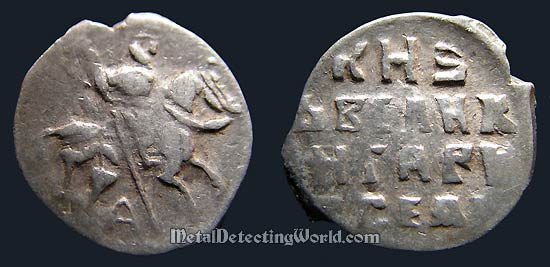
| < Prev. | ⇑ | Next > |

OBVERSE: an image of a horseman carrying a spear, the mint engraver's mark "А" under the galloping horse, circular dotted line.
REVERSE: the 5-line legend engraved in old Cyrillic letters reads: "КНS / ЬВЕЛИК / IИГАРЬ / ВСIЯР / УСИ" ("Prince and Grand Majesty of Entire Rus'"), circular dotted line.
Weight: 0.68 gram
Mint: Pskov
The name "Kopeck" ("Kopeyka" in Russian) first appeared during the 1535 monetary reform in Russia. The reform resulted in standardization of the hammered silver wire coinage in Russia; the northern Denga coins ("novgorodkas") being valued at twice the southern Dengas ("moskovkas"). When the production of new "novgorodkas" depicting a horseman with a spear began, the novgorodka coin was henceforth known as Kopeck (also spelled Kopek and Copeck). The coin's name was simply derived from the Russian word "kop'yo" meaning "spear". From 1547 onwards, the horseman on the Kopeck's obverse bears a crown which represented Ivan the Terrible, who was Grand Prince of All Rus' until 1547, and the first Russian Tzar thereafter.
In 1704, under the reign of Peter the Great, Russia was the first country in the world to introduce a decimal monetary system: 1 Rouble = 100 Kopecks. This system still remains unchanged in Russia, and St. George riding on horse and spearing a dragon is depicted on modern Russian 1 Kopeck, 5-Kopeck, 10-Kopeck and 50-Kopeck coins; thus, reflecting the original 1535 Novgorodka's design.
Number of pages:
Privacy Policy || Cookies Policy